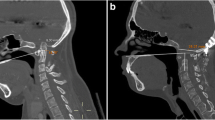Abstract
Introduction
In children as well as adults, adequate access to the craniocervical junction and upper cervical vertebra can usually be achieved with a transoral–transpalatopharyngeal route. However, when access is necessary to achieve the C5 level and the upper cervical spine in children, this is very difficult. This is particularly so when the incisor opening is less than 2.5 cm. The median labiomandibular glossotomy provides such an approach.
Materials and methods
Our experience with five children is presented in a representative case: a 4-year-old male with a family history of spondyloepiphyseal dysplasia presented with mild quadriparesis, 2 years earlier. This had rapid progression with severe upper cervical kyphosis. A standard transoral–transpalatopharyngeal approach or a lateral extrapharyngeal approach would not achieve exposure of the pathology. Hence, a median labiomandibular glossotomy was utilized for ventral decompression with an anterior interbody fusion between C2 and C4. Crown halo cervical traction was placed intraoperatively before a tracheostomy and tonsillectomy. A median labiomandibular glossotomy was then made with resection of the displaced odontoid process and the vertebral bodies of C3 and C4. This was followed by an anterior interbody fusion between the C2 and C4 vertebrae with costal rib grafts.
Result and conclusion
He was successfully decannulated during the second postoperative week upon resolution of lingual edema. A planned staged dorsal occipitocervical fusion was performed 6 months later, at which time the ventral fusion was quite solid. He had full neurological recovery.











Similar content being viewed by others
References
Ammirati M, Bernardo A (1998) Analytical evaluation of complex anterior approaches to the cranial base: an anatomic study. Neurosurgery 43(6):1398–1407
Arbit E, Patterson R (1981) Combined transoral and median labiomandibular glossotomy approach to the upper cervical spine. Neurosurgery 8(6):672–674
Balasingam V, Anderson G et al (2006) Anatomic analysis of transoral surgical approaches to the clivus. J Neurosurg 105:301–308
Crockard H (1985) The transoral approach to the base of the brain and upper cervical cord. Ann R Coll Surg Engl 67:321–325
Crockard H, Essigman W et al (1985) Surgical treatment of cervical cord compression in rheumatoid arthritis. Ann Rheum Dis 44:809–816
Delgado T, Garrido E et al (1981) Labiomandibular, transoral approach to chordomas in the clivus and upper cervical spine. Neurosurgery 8(6):675–679
Donald P (1998) Surgery of the skull base. Lippincott-Raven, Philadelphia
Fang H, Ong B (1962) Direct anterior approach to the upper cervical spine. J Bone Jt Surg 44:1588–1604
Floman Y, Kaplan L et al (1991) Transverse ligament rupture and atlanto-axial subluxation in children. J Bone Jt Surg Br 73(4):640–643
Hadley M, Spetzler R et al (1989) The transoral approach to the superior cervical spine. J Neurosurg 71:16–23
Harris J, Godin M et al (1989) The transoropalatal approach to the atlantoaxial-clival region: considerations for the head and neck surgeon. Laryngoscope 99:467–474
Hayakawa T, Kamikawa K et al (1981) Prevention of postoperative complications after a transoral transclival approach to basilar aneurysms. Technical note. J Neurosurg 54:699–703
Hitchcock E, Cowie R (1983) Transoral-transclival clipping of a midline vertebral artery aneurysm. J Neurol Neurosurg Psychiatry 46:446–448
Honma G, Murota K et al (1989) Mandible and tongue-splitting approach for giant cell tumor of the axis. Spine 14(11):1204–1210
Jones D, Hayter J et al (1998) Oropharyngeal morbidity following transoral approaches to the upper cervical spine. Int J Oral Maxillofac Surg 27:295–298
Kingdom T, Nockels R et al (1995) Transoral-transpharyngeal approach to the craniocervical junction. Otolaryngol Head Neck Surg 113:393–400
Martin H, Tollefsen H et al (1961) Median labiomandibular glossotomy. Am J Surg 102:753–759
Menezes AH, Graf C, Hibri N (1980) Abnormalities of the craniovertebral junction with cervicomedullary compression. A rational approach to surgical treatment in children. Child’s Brain 7(1):15–30
Menezes A (1991–1992) Complications of surgery at the craniovertebral junction—avoidance and management. Pediatr Neurosurg 17:254–266
Menezes A (1992) The anterior midline approach to the craniocervical region in children. Pediatr Neurosurg 18:272–281
Menezes A, VanGilder J (1988) Transoral–transpharyngeal approach to the anterior craniocervical junction. J Neurosurg 69:895–903
Menezes AH, Foltz GD (2005) Transoral approach to the ventral craniocervical border. Operative Techniques in Neurosurgery 8:150–157
Merwin G, Post J et al (1991) Transoral approach to the upper cervical spine. Laryngoscope 101:780–784
Moore L, Schwartz H (1985) Median labiomandibular glossotomy for access to the cervical spine. J Oral Maxillofac Surg 43:909–912
Sankar W, Wills B et al (2006) Os odontoideum revisited: the case for a multifactorial etiology. Spine 31(9):979–984
Shaha A, Johnson R et al (1993) Transoral–transpharyngeal approach to the upper cervical vertebrae. Am J Surg 166:336–340
Sherk H, Pratt L (1983) Anterior approaches to the cervical spine. Laryngoscope 93:168–171
Trotter W (1929) Operation for malignant disease of the pharynx. Br J Surg 16:485
Tuite G, Veres R et al (1996) Pediatric transoral surgery: indications, complications, and long-term outcome. J Neurosurg 84:573–583
Wessberg G, Hill S et al (1981) Median labiomandibular glossotomy. Int J Oral Maxillofac Surg 10:333–337
Wood B, Sadar E et al (1980) Surgical problems of the base of the skull. Arch Otolaryngol 106:1–5
Wood D, Good T et al (1990) Decompression of the brain stem and superior cervical spine for congenital/acquired craniovertebral invagination: an interdisciplinary approach. Laryngoscope 100:926–931
Author information
Authors and Affiliations
Corresponding author
Rights and permissions
About this article
Cite this article
Brookes, J.T., Smith, R.J.H., Menezes, A.H. et al. Median labiomandibular glossotomy approach to the craniocervical region. Childs Nerv Syst 24, 1195–1201 (2008). https://doi.org/10.1007/s00381-008-0609-5
Received:
Published:
Issue Date:
DOI: https://doi.org/10.1007/s00381-008-0609-5




